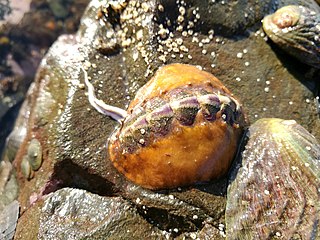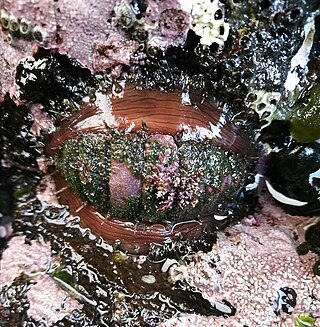
Chitons are marine molluscs of varying size in the class Polyplacophora, formerly known as Amphineura. About 940 extant and 430 fossil species are recognized.

The gumboot chiton, also known as the giant western fiery chiton or giant Pacific chiton, is the largest of the chitons, growing to 36 cm (14 in) and capable of reaching a weight of more than 2 kg (4.4 lb). It is found along the shores of the northern Pacific Ocean from Central California to Alaska, across the Aleutian Islands to the Kamchatka Peninsula and south to Japan. It inhabits the lower intertidal and subtidal zones of rocky coastlines. The gumboot chiton's appearance has led some tidepoolers to refer to it, fondly, as the "wandering meatloaf". The name "gumboot chiton" seems to derive from a resemblance to part of a rubber Wellington boot or "gum rubber" boot.

Eudoxochiton nobilis, commonly called the noble chiton, is a large chiton of the family Callochitonidae. The Māori name is Rangitīra.

Chiton glaucus, common name the green chiton or the blue green chiton, is a species of chiton, a marine polyplacophoran mollusk in the family Chitonidae, the typical chitons. It is the most common chiton species in New Zealand. Chiton glaucus is part of a very primitive group of mollusc with evidence of being present in up to 80 million years of the fossil record.

Cryptoconchus porosus, the butterfly chiton, is a species of chiton, a marine polyplacophoran mollusc in the family Acanthochitonidae.

Ischnochiton maorianus, sometimes called the variable chiton, is a fast moving species of chiton in the family Ischnochitonidae, endemic to the main islands of New Zealand where it is abundant.

Sypharochiton pelliserpentis is a species of chiton in the family Chitonidae. As the species name suggests, the surface of the girdle in this chiton has a pattern of overlaying scales resembling snakeskin, and it is commonly referred to as the snakeskin chiton. The Māori name for the species is papatua.

Acanthochitona zelandica is a species of chiton in the family Acanthochitonidae, also sometimes known as the hairy, or "tufted", chiton. It probably developed during the mid to late Pleistocene, and is endemic to New Zealand.

Notoplax violacea is a species of chiton in the family Acanthochitonidae, endemic to all coasts of New Zealand, where it is common in northern areas.

Acanthopleura granulata, common name the West Indian fuzzy chiton, is a medium-sized tropical species of chiton. This type of chiton's activity does not depend on spring-neap oscillations leading to lower locomotion loss. Its morphology is different from usual chitons as it has a fifth valve, which is split into halves.

Acanthochitonidae is a family of marine mollusks belonging to the class Polyplacophora, commonly known as chitons. Species are widely distributed throughout the world's oceans, but are most commonly found in the shallow waters of the Pacific Ocean, from Alaska to Chile.
Chaetopleura pertusa, the orange hairy chiton, is a species of chitons in the family Chaetopleuridae. It is a marine mollusc. It is endemic to South Africa.

Acanthochitona fascicularis is a common chiton in the family Acanthochitonidae.

A girdle is part of the anatomy of a chiton, one class of marine mollusks, the class Polyplacophora. The shell of a chiton consists of eight valves which articulate with one another. The girdle is a strong but flexible structure that in most cases encircles the plates, holding them all together.

Plaxiphora albida, the white Plaxiphora chiton, is a species of chiton in the family Mopaliidae.
Plaxiphora boydeni is a small uncommon chiton in the family Mopaliidae, endemic to the East Coast of the South Island, New Zealand, Stewart Island and the Chatham and Subantarctic Islands.
Plaxiphora caelata is a small chiton in the family Mopaliidae, endemic to the main islands of New Zealand, Stewart Island and the Chatham Islands.

Plaxiphora biramosa is an uncommon chiton in the family Mopaliidae, endemic to New Zealand.

Plaxiphora obtecta is a large chiton in the family Mopaliidae, endemic to New Zealand, where it is most often found on the West Coast of the North Island. It is called Haka-hiwihiwi by some Māori and was likely a food source.

Acanthochitona crinita is a species of marine chiton in the family Acanthochitonidae. It is found on rocky coasts in the northeastern Atlantic Ocean, the North Sea and the Mediterranean Sea.














